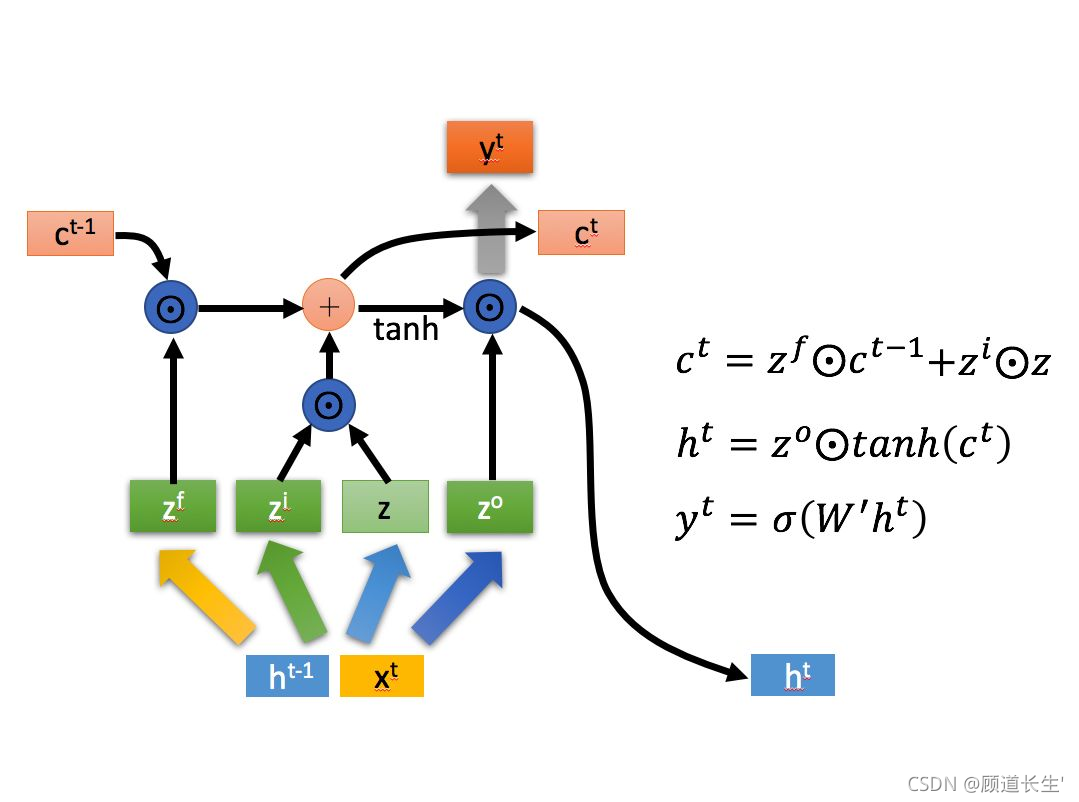
文章目录
- LSTM原理图
- 便于程序实现的公式(简化版公式)
- 关于“门”
- 遗忘门
- 输入门
- 更新memory
- 输出门
- LSTM单元
详细理论部分参考我博文(2020李宏毅)机器学习-Recurrent Neural Network
LSTM原理图

公式
便于程序实现的公式(简化版公式)
关于“门”
遗忘门
在LSTM中,遗忘门可以实现操作:
在这里,是控制遗忘门行为的权重。将
连接起来,然后乘以
。上面的等式使得向量
的值介于0到1之间。该遗忘门向量将逐元素乘以先前的单元状态
。因此,如果
的其中一个值为0(或接近于0),则表示LSTM应该移除
中的一部分信息,如果其中一个值为1,则它将保留信息。
输入门
输入门的公式:
类似于遗忘门,在这里也是值为0到1之间的向量。这将与
逐元素相乘以计算
。
更新memory
新的输入向量:
最后,新的memory状态为:
输出门
为了确定接下来将使用哪些输出,使用以下两个公式:
LSTM单元
实现上图中描述的LSTM单元。
说明:
- 将
和
连接在一个矩阵中:
- 计算以上公式,使用
sigmoid()和np.tanh()。 - 计算预测
,使用
softmax()。 - 预测
公式为
import numpy as
def sigmoid(x):
return 1/(1+np.exp(-x))
def softmax(x):
e_x = np.exp(x-np.max(x))# 防溢出
return e_x/e_x.sum(axis=0)
def LSTM_CELL_Forward(xt,h_prev,C_prev,parameters):
"""
Arguments:
xt:时间步“t”处输入的数据 shape(n_x,m)
h_prev:时间步“t-1”的隐藏状态 shape(n_h,m)
C_prev:时间步“t-1”的memory状态 shape(n_h,m)
parameters
Wf 遗忘门的权重矩阵 shape(n_h,n_h+n_x)
bf 遗忘门的偏置 shape(n_h,1)
Wi 输入门的权重矩阵 shape(n_h,n_h+n_x)
bi 输入门的偏置 shape(n_h,1)
Wc 第一个“tanh”的权重矩阵 shape(n_h,n_h+n_x)
bc 第一个“tanh”的偏差 shape(n_h,1)
Wo 输出门的权重矩阵 shape(n_h,n_h+n_x)
bo 输出门的偏置 shape(n_h,1)
Wy 将隐藏状态与输出关联的权重矩阵 shape(n_y,n_h)
by 隐藏状态与输出相关的偏置 shape(n_y,1)
Returns:
h_next -- 下一个隐藏状态 shape(n_h,m)
c_next -- 下一个memory状态 shape(n_h,m)
yt_pred -- 时间步长“t”的预测 shape(n_y,m)
"""
# 获取参数字典中各个参数
Wf = parameters["Wf"]
bf = parameters["bf"]
Wi = parameters["Wi"]
bi = parameters["bi"]
Wc = parameters["Wc"]
bc = parameters["bc"]
Wo = parameters["Wo"]
bo = parameters["bo"]
Wy = parameters["Wy"]
by = parameters["by"]
# 获取 xt 和 Wy 的维度参数
n_x, m = xt.shape
n_y, n_h = Wy.shape
#拼接 h_prev 和 xt
concat = np.zeros((n_x+n_h,m))
concat[: n_h, :] = h_prev
concat[n_h :, :] = xt
# 计算遗忘门、输入门、记忆细胞候选值、下一时间步的记忆细胞、输出门和下一时间步的隐状态值
ft = sigmoid(np.dot(Wf,concat)+bf)
it = sigmoid(np.dot(Wi,concat)+bi)
cct = np.tanh(np.dot(Wc,concat)+bc)
c_next = ft*c_prev + it*cct
ot = sigmoid(np.dot(Wo,concat)+bo)
h_next = ot*np.tanh(c_next)
# LSTM单元的计算预测
yt_pred = softmax(np.dot(Wy, h_next) + by)
return h_next,c_next,yt_pred
np.random.seed(1)
xt = np.random.randn(3,10)
h_prev = np.random.randn(5,10)
c_prev = np.random.randn(5,10)
Wf = np.random.randn(5, 5+3)
bf = np.random.randn(5,1)
Wi = np.random.randn(5, 5+3)
bi = np.random.randn(5,1)
Wo = np.random.randn(5, 5+3)
bo = np.random.randn(5,1)
Wc = np.random.randn(5, 5+3)
bc = np.random.randn(5,1)
Wy = np.random.randn(2,5)
by = np.random.randn(2,1)
parameters = {"Wf": Wf, "Wi": Wi, "Wo": Wo, "Wc": Wc, "Wy": Wy, "bf": bf, "bi": bi, "bo": bo, "bc": bc, "by": by}
h_next, c_next, yt = LSTM_CELL_Forward(xt, h_prev, c_prev, parameters)
print("a_next[4] = ", h_next[4])
print("a_next.shape = ", c_next.shape)
print("c_next[2] = ", c_next[2])
print("c_next.shape = ", c_next.shape)
print("yt[1] =", yt[1])
print("yt.shape = ", yt.shape)
a_next[4] = [-0.66408471 0.0036921 0.02088357 0.22834167 -0.85575339 0.00138482
0.76566531 0.34631421 -0.00215674 0.43827275]
a_next.shape = (5, 10)
c_next[2] = [ 0.63267805 1.00570849 0.35504474 0.20690913 -1.64566718 0.11832942
0.76449811 -0.0981561 -0.74348425 -0.26810932]
c_next.shape = (5, 10)
yt[1] = [0.79913913 0.15986619 0.22412122 0.15606108 0.97057211 0.31146381
0.00943007 0.12666353 0.39380172 0.07828381]
yt.shape = (2, 10)
预期输出:
a_next[4] = [-0.66408471 0.0036921 0.02088357 0.22834167 -0.85575339 0.00138482
0.76566531 0.34631421 -0.00215674 0.43827275]
a_next.shape = (5, 10)
c_next[2] = [ 0.63267805 1.00570849 0.35504474 0.20690913 -1.64566718 0.11832942
0.76449811 -0.0981561 -0.74348425 -0.26810932]
c_next.shape = (5, 10)
yt[1] = [0.79913913 0.15986619 0.22412122 0.15606108 0.97057211 0.31146381
0.00943007 0.12666353 0.39380172 0.07828381]
yt.shape = (2, 10)
参考
https://zh-v2.d2l.ai/chapter_recurrent-modern/lstm.htmlhttps://www.heywhale.com/mw/project/6174b96ef7e7c300175739cc









